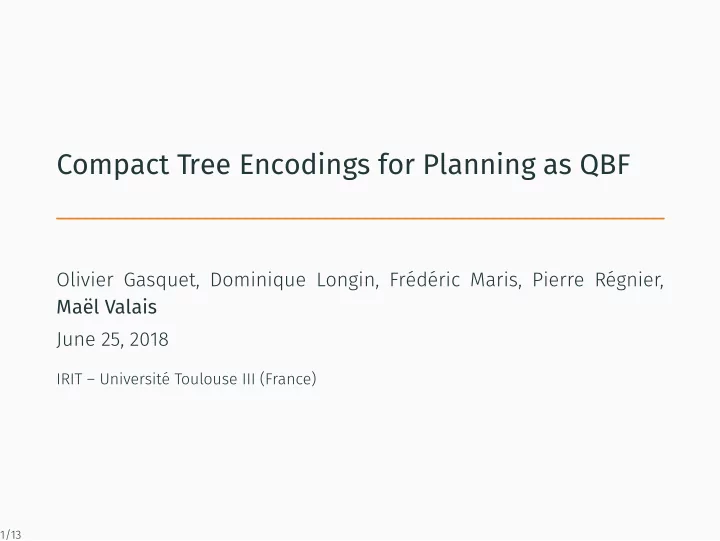

Olivier Gasquet, Dominique Longin, Frédéric Maris, Pierre Régnier, June 25, 2018 IRIT – Université Toulouse III (France) 1/13 Compact Tree Encodings for Planning as QBF Maël Valais
Planning as QBF and CTE framework Our contribution : exploring new encodings for faster solving 2/13
Planning as QBF and CTE framework
What is QBF? 3/13 SAT QBF = + ¬ ∨ ∧ → ∀ ∃ SAT X 0 one state = one copy of each variable QBF ∀ b two contexts using same variables less memory X 0 X 0
Why should QBF be explored? • Satplan wins IPC’04 and IPC’06 due to improvements in SAT solvers thanks to SAT competitions • QBF solvers competitions are taking off, more and more attention 4/13 − → QBF solvers are (probably) going to get much faster
5/13 O ( n ) in memory space SAT begin end planning X 0 X 1 X 2 X 3 X 4 X 5 X 6 X 2 X 1 X 1 QBF planning (CTE) X 0 X 0 X 0 X 0 begin end O ( log ( n )) in memory space → Theoretically, much less memory used. −
In practice : • Using SAT, No-ops are the best available transition (from [Cashmore et al., 2012]) better results? we only work at the encoding level, not the solver-level 6/13 • Using QBF, No-ops uses 5 × less memory but 30 × slower Question : could we find other CTE-based encodings yielding Note
Our contribution : exploring new encodings for faster solving
7/13 EFA OPEN Sa tplan Source (expl anatory frame-axioms) (invented) SAT (No-ops) encoding from from State-Space Planning Plan-Space Planning QBF CTE-EFA CTE-OPEN CTE-NOOP encoding reference our work
• Across most IPC domains (1 to 8) • QBF solvers tested : RaREQS, DepQBF, Qute (Quantor too slow) • around 6000 hours of compute time (2112 problems tried across 3 solvers) • 1-hour timeout for solving the problem ”is there a plan?” • https://github.com/touist/touist • https://github.com/touist/touistplan 8/13 • QBF problems generated using TouIST and TouISTPlan
9/13 (compared to CTE-NOOP) Time between CTE encodings when solving ”is there a plan?” : 3500 3500 y = x x = y 3000 3000 Time in seconds (CTE-OPEN) Time in seconds (CTE-EFA) 2500 2500 2000 2000 y = 0.5953x y = 0.4843x 1500 1500 1000 1000 500 500 0 0 0 1000 2000 3000 0 1000 2000 3000 Time in seconds (CTE-NOOP) Time in seconds (CTE-NOOP) CTE-OPEN is 1.7 × faster CTE-EFA is 2 × faster We went from 30 × to only 15 × slower than Satplan!
10/13 Practical shortcoming : we can only handle a depth of 3, i.e., maximum plan span of 15 steps !
• Number of literals and number of clauses 11/13 Metrics for explaining this 2 × improvement? • Ratio between types of transitions ( branch -based constraints over node -based constraints)
Encoding Nb solved • Type of transitions (node/branch) : no pattern Not very helpful : 17% -28% -2% -41% 445 (21%) CTE-OPEN 47% +15% -26% -55% 463 (22%) CTE-EFA 30% 0% 0% 0% 412 (20%) CTE-NOOP Transitions ratio Clauses Literals Time 12/13 • Number of literals and number of clauses : no pattern
Conclusion
To sum up : QBF problems Future : solvers to get better on this area improvements 13/13 • A systematic way of translating encodings from SAT into • As a result, two new encodings improving over the existing CTE-NOOP • A large set of benchmarks generated using all IPC • Publish our new benchmarks (QBFEVAL) for pushing QBF • Find more metrics for explaining and exploiting these
Cashmore, M., Fox, M., and Giunchiglia, E. (2012). In Raedt, L. D., Bessière, C., Dubois, D., Doherty, P., Frasconi, P., Heintz, F., and Lucas, P. J. F., editors, ECAI 2012 - 20th European Conference on Artificial Intelligence. Including Prestigious Applications of Artificial Intelligence (PAIS-2012) System Demonstrations Track, Montpellier, France, August 27-31 , 2012 , volume 242 of Frontiers in Artificial Intelligence and Applications , pages 217–222. IOS Press. Kautz, H. (2004). In Abstracts of the 4th International Planning Competition, IPC-04 . Kautz, H., Selman, B., and Hoffmann, J. (2006). 13/13 Planning as quantified boolean formula. Satplan04 : Planning as satisfiability. SatplanÕ04 : Planning as satisfiability.
In Abstracts of the 5th International Planning Competition, IPC-06 . 13/13
Recommend
More recommend